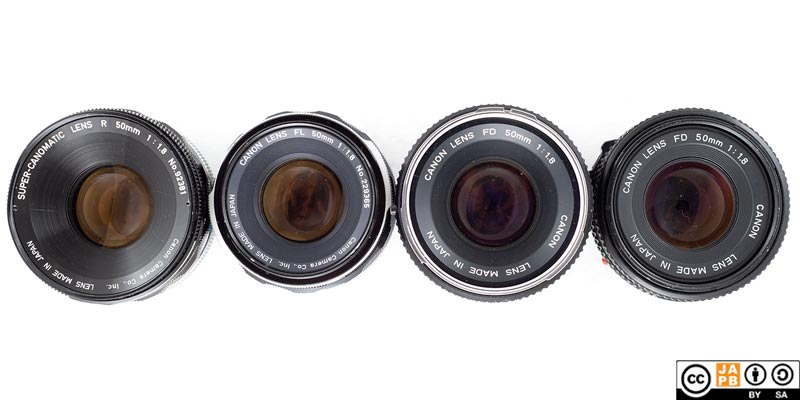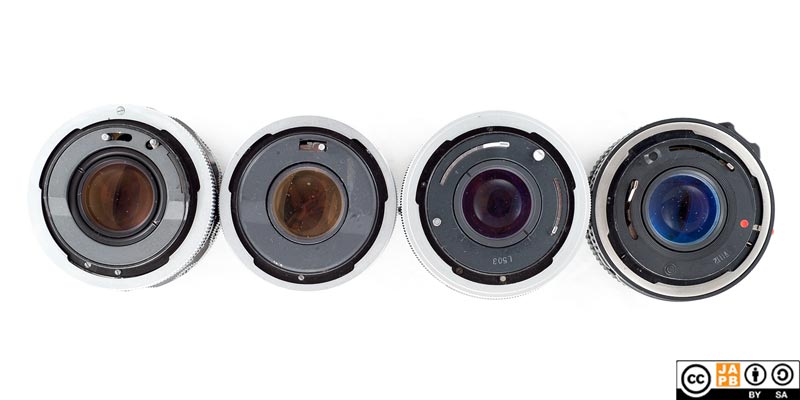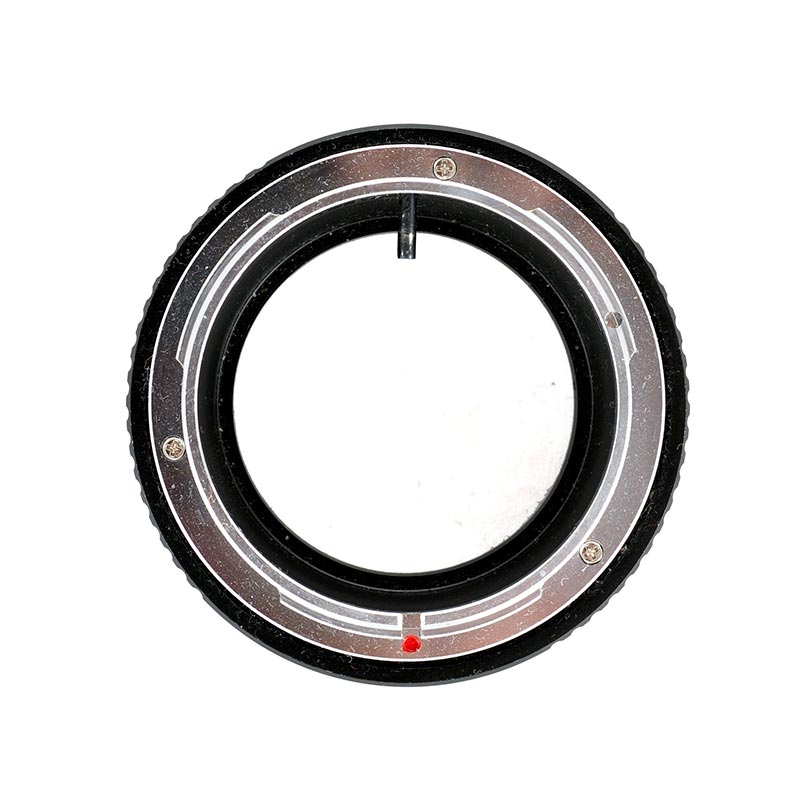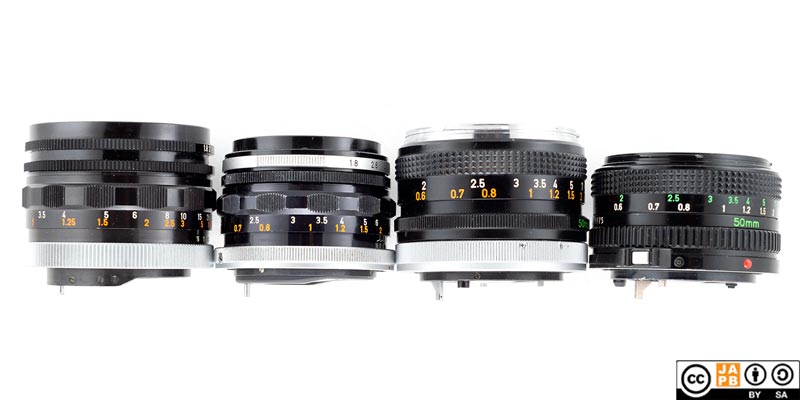This article focuses on how to adapt those Canon R and Canon FL mount lenses that have a bulge in the rearward facing part of the lens, that interferes with the normal operation of typical Canon FD to <mirrorless system> adapters. If you want to jump straight to the solution, click here. If you’re interested in the back story, read on.
28 years, 4 mounts and a ton of great lenses
From the 1959 to 1987, Canon used a series of four more or less compatible lens mounts:
- The Canon R (Canomatic) mount 1959–1964
- The Canon FL mount 1964–1971
- The Canon FD mount 1971–1979
- The Canon new FD (FDn) mount 1979–1987
This progression is perfectly exemplified by the quartet of lenses below.

• Super Canomatic (R) 50 mm f/1.8 (III) (1963-1964)
• Canon FL 50 mm f/1.8 (I) 1964-1968
• Canon FD 50 mm f/1.8 ‘chrome nose’ (II) 1971–1973 [data sheet]
• Canon FDn 50 mm f/1.8 (1979–1987) [data sheet]
The commonalities
These lens mounts are compatible in that the physical mount (the parts that exist to secure the lens onto the camera) on the camera end stayed identical throughout. This opens the door to theoretically being able to use the same adapter for almost 30 years worth of Canon SLR lenses. And the short answer is yes and no. Read on.
The incompatibilites
There were reasons for why Canon first abandoned the R mount in favour of the FL mount after only 5 years, only to do the same again (FL to FD) 7 years later, and again (FD to FDn) 8 years later, and a final time after 8 more years (FDn to EF) 1.
The short version of the reasoning is that as the abilities of cameras (and the tastes of photographers) developed and always showed the shortcomings of the mount. Especially in the communication abilities between lens and camera. Because these incompatibilities are mostly related to the lens’ ability to communicate with a Canon camera of a slightly different generation, these incomatibilities are somewhat incidental to this article, we’ll not spend too much time on them:
Canon R (Canomatic) mount [main article]:
• Three-pronged breech-loch mount with locking ring on lens.
• Lenses can operate as either manual aperture lenses, or be stopped down to a preselected aperture value by compatible camera.
• Lens base has two levers: one for for arming the auto aperture and another for triggering it
Canon FL mount [main article]:
• Three-pronged breech-loch mount with locking ring on lens. (identical to Canon R)
• Lenses can operate as either preset lenses, or be stopped down to a preselected aperture value by compatible camera.
• Lens base has one lever for stopping down the lens to the preselected value.
Canon FD mount [main article]:
• Three-pronged breech-loch mount with locking ring on lens. (identical to Canon R and FL)
• Lenses are pure auto aperture lenses and need a camera (or adapter) to stop down the lens to a preselected aperture value.
• Lens base has one lever for stopping down the lens to the preselected value and another one to communicate the selected aperture ring position to a compatible body.
Canon FDn mount [main article]:
• Three-pronged female bayonet mount (however fully compatible with Canon FD bodies/lenses)
• Lenses are pure auto aperture lenses and need a camera (or adapter) to stop down the lens to a preselected aperture value.
• Lens base has one lever for stopping down the lens to the preselected value and another one to communicate the selected aperture ring position to a compatible body.

Note that the FDn’s control levers are not at the same positions as with the FD lens. This is because the FDn mount’s attachment procedure rotates the entire inner mount assembly.
(As is customary at JAPB, lens mounts are always photographed with the lens’ up pointing down (at 6 o’clock)
The BULGE – The one incompatibility that matters when adapting.
For an adapter to allow you to engage the aperture mechanism on FD and FDn lenses it needs to have a pin, coupled to a control ring on the adapter, that you can use to engage the aperture stop down of those lenses. Without such a pin, the lens’ aperture will remain wide open. Therefore, all Canon FD adapters sport such a pin.

And here comes the rub, because some 2 (not all, but some) of Canon R and Canon FL lenses have a protruding ‘bulge’ in the back of the mount. That design difference is perfectly evident in the sidelong shot of the quartet (below):

(In the picture the lens’ ‘up’ is always facing right. Notice the protrusion or bulge in both the Canon R and Canon FL lens?
Depending on your lens (not all R/FD lenses have a bulge, and not all bulges are equally big) and your adapter (how close to the mount the adapter’s pin is installed varies a bit), your Canon R / FL might or might not mount on your Canon FD adapter. Bummer.
The solution
There actually is an easy solution to this: Remove the pin.
Let me explain.
First, you need to remember that only Canon FD and FDn lenses actually need that pin. On Canon R lenses it does nothing, and while you can use it to stop down Canon FL lenses, Canon FL lenses do not depend on that pin. Instead Canon FL lenses always also have a mode that allow manual aperture operation. So if that pin precludes you from mounting your Canon R or Canon FL lens that has a bulge, remove the pin.
Moreover, due to how these adapters are mostly2 designed removing that pin is usually both easy and non-destructive (i.e. you can put it back). For example, in the case of the above pictured K&F adapter, the entire ‘pin’ is actually a screw that does not have threads in the part sticking into the adapter. This means you only need a screwdriver (or in rare cases a hex key) to remove the pin. Presto, your Canon FD/FDn adapter has been transformed into a perfect Canon R/FLadapter. Make sure to save the crew.
(Obviously, JAPB does recommend you modify one of your (at least) two Canon FD adapters).
Footnotes
1 Compared to most other contemporary SLR lens mounts, Canon’s pace of obsoleting its lens mounts was decidedly rapid. For example Konica – after having introduced the short-lived Konica F-mount in 1960 – introduced the Konica AR mount in 1965 (both one year behind Canon’s R and FL mounts). But Konica managed to implement the entire repertoire of the FDn mount in the AR mount and did not need to change it for the next 24 years, whereas Canon went through two more iterations. And let’s not mention Canon’s arch-rival Nikon which managed to keep its F-mount all the way from 1959 to today…
2 Based on my own inventory (* and trustworthy online sources), I can ascertain the situation on the following lenses:
R 35/2.5 HAS bulge *
R 50/1.8 HAS bulge
R 55-135/3.5 no bulge *
R 58/1.2 HAS bulge *
R 85/1.8 no bulge *
R 100/2 HAS bulge *
R 135/2.5 no bulge *
R 135/3.5 no bulge * (unclear whether type I or II, SN #10477)
FL 28/3.5 no bulge
FL 35/2.5 HAS bulge
FL 50/1.4 (I & II) no bulge
FL 50/1.8 (I) HAS bulge
FL 50/1.8 (II) no bulge
FL 55/1.2 no bulge
FL 58/1.2 (I) HAS bulge *
FL 85/1.8 no bulge
FL 100/3.5no bulge
FL 135/2.5 no bulge *
FL 135/3.5 no bulge *
FL 200/3.5 (II) no bulge *
FL 200/4.5 no bulge *
3 This judgment is based on a quick check of 5 different make Canon FD adapters I have lying around.